Order Siluriformes Higher classification Pangasianodon | Phylum Chordata Family Pangasiidae Scientific name Pangasianodon gigas Rank Species | |
 | ||
Similar Catfish, Shark catfish, Pangasianodon, Giant barb, Arapaima | ||
Mekong giant catfish national geographic
The Mekong giant catfish, Pangasianodon gigas (Thai: ปลาบึก, rtgs: pla buek, [plāː bɯ̀k]; Khmer: ត្រីរាជ /trəy riec/; Vietnamese: cá tra dầu), is a very large, critically endangered species of catfish (order Siluriformes) in the shark catfish family (Pangasiidae), native to the Mekong basin in Southeast Asia and adjacent China. In Thai folklore, this fish is regarded with reverence, and special rituals are followed and offerings are made before fishing it.
Contents
- Mekong giant catfish national geographic
- How to make bait for mekong giant catfish
- Distribution and habitat
- Feeding
- Appearance and size
- Conservation
- References
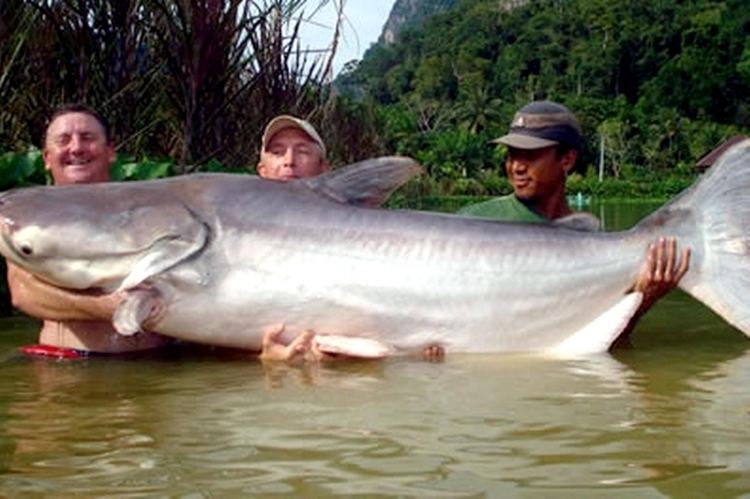
How to make bait for mekong giant catfish
Distribution and habitat
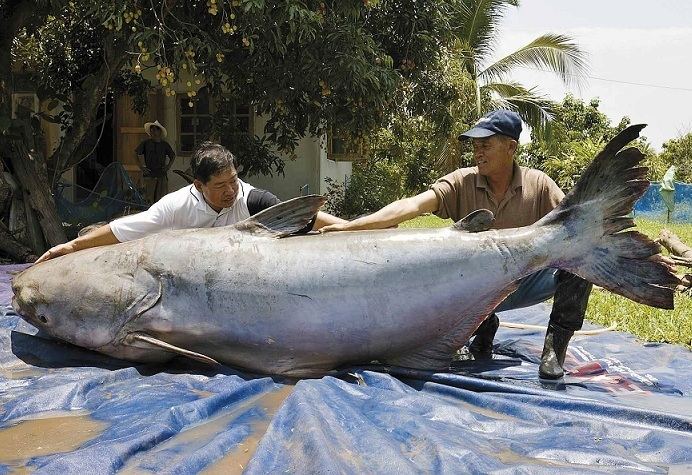
The Mekong giant catfish is a threatened species in the Mekong, and conservationists have focused on it as a flagship species to promote conservation on the river. Although research projects are currently ongoing, relatively little is known about this species. Historically, the fish's natural range reached from the lower Mekong in Vietnam (above the tidally influenced brackish water of the river's delta) all the way to the northern reaches of the river in the Yunnan province of China, spanning almost the entire 4,800 km (3,000 mi) length of the river. Due to threats, this species no longer inhabits the majority of its original habitat; it is now believed to only exist in small, isolated populations in the middle Mekong region. Fish congregate during the beginning of the rainy season and migrate upstream to spawn. They live primarily in the main channel of the river, where the water depth is over 10 m (33 ft), while researchers, fishermen and officials have found this species in the Tonle Sap River and Lake in Cambodia, a UNESCO Biosphere Reserve. In the past, fishermen have reported the fish in a number of the Mekong's tributaries; today, however, essentially no sightings are reported outside of the main Mekong river channel and the Tonle Sap region.
Feeding
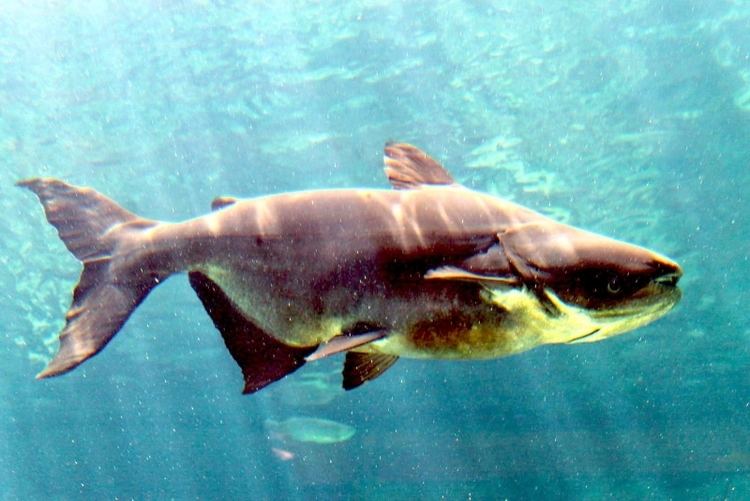
As fry, this species feeds on zooplankton in the river and is known to be cannibalistic. After approximately one year, the fish becomes herbivorous, feeding on filamentous algae, probably ingesting larvae and periphyton accidentally. The fish likely obtains its food from algae growing on submerged rocky surfaces, as it does not have any sort of dentition.
Appearance and size
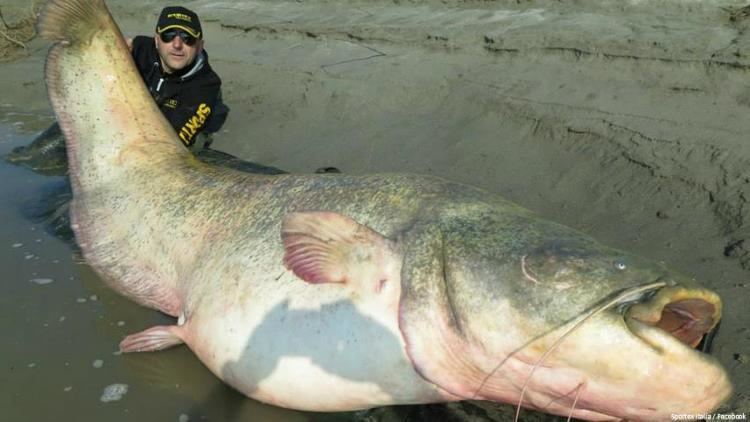
Grey to white in colour and lacking stripes, the Mekong giant catfish is distinguished from other large catfish species in this river by the near-total lack of barbels and the absence of teeth. The Mekong giant catfish currently holds the Guinness Book of World Records' position for the world's largest freshwater fish. Attaining an unconfirmed length of 3 m (9.8 ft), the Mekong giant catfish grows extremely quickly, reaching a mass of 150 to 200 kg (330 to 440 lb) in six years. It can reportedly weigh up to 350 kg (770 lb). The largest catch recorded in Thailand since record-keeping began in 1981 was a female measuring 2.7 m (8 ft 10 in) in length and weighing 293 kg (646 lb). This specimen, caught in 2005, is widely recognized as the largest freshwater fish ever caught (although the largest sturgeon species can far exceed this size, they are anadromous). Thai Fisheries officials stripped the fish of its eggs as part of a breeding programme, intending then to release it, but the fish died in captivity and was sold as food to local villagers.
Conservation
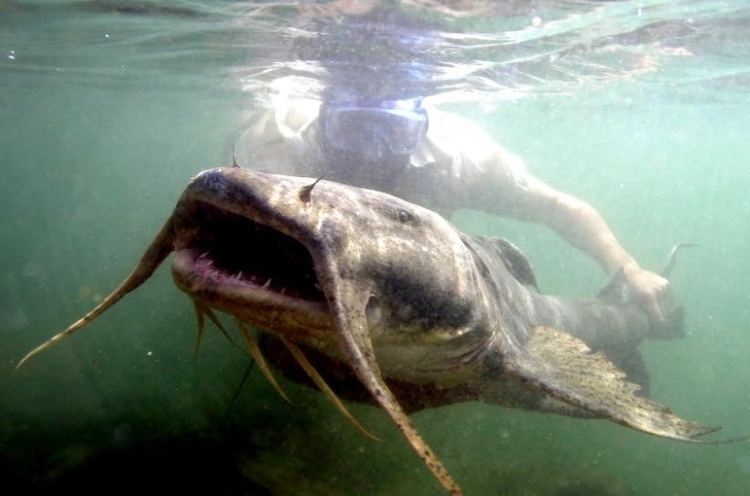
Endemic to the lower half of the Mekong River, this catfish is in danger of extinction due to overfishing, as well as the decrease in water quality due to development and upstream damming. The current IUCN Red List for fishes classes the species as Critically Endangered; the number living in the wild is unknown, but catch data indicate the population has fallen by 80% in the last 14 years. It is also listed in Appendix I of CITES, banning international trade involving wild-caught specimens.
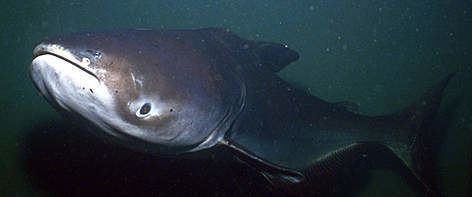
In The Anthropologists' Cookbook (1977), Jessica Kuper noted the importance of the pa beuk to the Lao people and remarked, "In times gone by, this huge fish, which is found only in the Mekong, was fairly plentiful, but in the last few years, the number taken annually has dwindled to forty, thirty or twenty, and perhaps in 1976 even fewer. This is sad, as it is a noble fish and a mysterious one, revered by the Lao."
Fishing for the Mekong giant catfish is illegal in the wild in Thailand, Laos and Cambodia, but the bans appear to be ineffective and the fish continue to be caught in all three countries. However, in recognition of the threat to the species, nearly 60 Thai fishermen agreed to stop catching the endangered catfish in June 2006, to mark the 60th anniversary of Bhumibol Adulyadej's ascension to the throne of Thailand. Thailand is the only country to allow fishing for private stocks of Mekong giant catfish. This helps save the species, as lakes purchase the small fry from the government breeding programme, generating extra income that allows the breeding program to function. Fishing lakes, such as Bueng Samran (บึงสำราญ) in Bangkok, have the species up to 140 kg (310 lb). The most common size landed is 18 kg (40 lb), although some companies specialise in landing the larger fish.
The species needs to reach 50–70 kg (110–150 lb) to breed, and it does not breed in lakes. The Thailand Fishery Department has instituted a breeding programme to restock the Mekong River. From 2000 to 2003, about 10,000 captive-bred specimens were released by the Thai authorities. At present, specimens are released into reservoirs rather than the Mekong River itself.
